|
E. H. Crump of Memphis
...Historic "Boss" of the city 1910-1954 |
|
|
|
|
|
|
|
Edward Hull Crump was the dominant force in Memphis politics for most of the first half of the 20th century.
And he also dominated the state of Tennessee politics for most
of the time from the 1920s to the 1940s. He was only
mayor of Memphis from 1910 through 1915, and again briefly in
1940. But, he effectively appointed every city mayor
from 1915 to 1954. He was the "Boss" and
ran the city of Memphis at
the same time as Mayor Richard Daley ran everything in
Chicago. This is his story. |
|
|
|
|
|
|
|
|
|
|
|
|
|
Click on small
photos to see an enlargement |
|
|
|
|
|
|
|
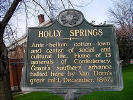 |
E.
H. Crump, a native of Holly Springs, Mississippi, was born in 1874.
His father died in 1878 of Yellow Fever and his widowed mother along with
young Ed and two other children, moved in with her family at the Sam McCorkle house in Holly
Springs. It was not an easy life for the family and Ed dropped out of school
at 14 and went to work. He then took a course in bookkeeping
and began working his way up to management. From the beginning
he was good at business. |
|
|
|
|
|
 |
 |
 |
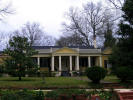 |
|
Holly Springs, MS |
Holly Springs, MS |
Sam McCorkle House |
Crump Place |
|
|
|
|
Seventeen year old Ed moved to Memphis in 1893
with only a few bucks in his pocket. When he arrived,
the city was involved in the worst recession in the United
States up to that time and it was difficult for him.
He did however have plans, and was able to obtain a clerical position with the Walter
Goodman Cotton Company on Front Street. This was the
beginning of a successful business career. Always one to
think of bettering himself, Ed joined social clubs hoping to
meet the right people. Within ten years his
political career began, as a delegate to the state convention
and a spot on the Board of Public Works.
|
 |
| |
|
|
|
|
|
|
|
|
|
In
1901, Crump began courting a 23 year old woman named Bessie Byrd
McLean a prominent Memphis socialite who was said to be "one
of the city's most beautiful and most sought after women." She
was the only child of Mr. and Mrs. Robert McLean. Robert
was then vice president of the William R. Moore Dry Goods Company.
Crump and Bessie were married January 22, 1902 at the Calvary
Episcopal Church. |
|
|
|
|
|
|
|
|
|
At
the time of his marriage, Ed was treasurer of
Woods-Chickasaw Manufacturing Co, a carriage-saddle firm. His wife's father provided him with the
funds to buy the company and the name was changed to "E. H.
Crump Buggy and Harness Co". After 8 successful years he
sold it to devote all his time to public office. Crump and Betty had three
sons, Ed Jr, Robert, and John. He was supposedly a
devoted family man, and his family cared deeply for him,
although it never looks like it in family photos. The
Crump home at 1962 Peabody Avenue was built in 1909 with Doric
Columns and a Greek Revival Porch. |
 |
| |
Bessie
and Ed |
|
|
|
|
 |
 |

|
 |
 |
|
Crump 1948
|
Calvary |
Crump
Home: 1962 Peabody |
Crump
departs |
Crump home today |
|
|
|
 |
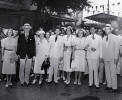 |
 |
 |
 |
|
138 Rare photos of the entire
Crump family |
Memphis
Magazine |
Crump's
Death |
1954
Funeral |
|
|
|
|
|
|
|
|
<> <> <> |
|
|
|
|
|
E.
H. Crump began to make political connections that served
him for the rest of his life. He was a delegate to the
Tennessee Democratic State Convention in 1902 and 1904.
In 1905 he was named to the municipal Board of Public Works
and appointed Commissioner of Fire and Police in 1907.
He was on his way. In
1909, W. C. Handy wrote the first blues song. It was actually
a campaign theme for E. H. Crump called "Boss Crump
Blues" and was later published as "The Memphis Blues".
It really caught on quickly in the clubs, in part, due to its
unique sound. Crump was elected for his first term
as Mayor or Memphis. |
 |
 |
| |
Commisioner |
Boss
Crump Blues |
|
|
|
 |
In
1910 crump began to build a political machine which came to have
statewide influence. He was particularly adept in the use of
what were the two politically weak minority groups in Tennessee -
blacks and Republicans. Unlike most Southern Democrats of his
time, Crump was not opposed to blacks voting in Memphis and
they, for the most part were reliable Crump machine voters. A
relationship developed in which they aided him and he aided them.
He also skillfully manipulated Republicans, who were numerically
very weak in Tennessee. They frequently found it necessary to
align themselves with Crump in order to accomplish any of their
goals. |
| Crump
1911 |
|
|
|
|
|
When he was Commissioner of
Fire and Police, Crump began a life-long interest in building
the best Fire and Police Departments in the country. He
campaigned to upgrade both departments and to build inspiring
public buildings for them. After he became Mayor in 1910,
he followed through on this. Memphis Fire House #1 was
built in 1910 and Crump continuously supported upgrading the
fire department equipment and turning it into an all motorized
department by 1919. |
 |
| |
Fire
Station #1 |
|
|
|
|
|
|
When the Great Depression hit, Crump was in firm control of Memphis.
Even if he weren't in an elected office at the time, one of his
supporters would be. Few politicians were elected to statewide
office during this time without the support of the Crump political
machine. When Crump ran for County Trustee in 1916 and won, he
developed a technique for registering voters that served him well
over the next three decades. Firemen and police officers who
were now his friends, were
taken off duty and used to transport people to register to vote.
25,000 voters were added to the polls in this election.
Crump's personal honesty was never questioned. He wouldn't
steal a nickel - just an election! |
 |
| |
Crump |
|
|
|
|
|
|
Crump was county treasurer of Shelby County from 1917 to 1923.
This gave him the salary he needed. He
was also a delegate to the Democratic National Convention seven times.
During this time he decided to run Memphis through intermediaries.
He set up his own insurance company in the Memphis Savings Bank
building. He named it "The Crump Insurance Co" and ran
Memphis from the company
office on the 6th floor - unofficially.
Those in government or wanting business with the Memphis government found it
advisable to get their insurance from Crump's Insurance agency.
|
 |
| |
Crump
Ins Co |
|
|
|
|
|
|
|
|
When Crump last left the
mayor's office he left what he thought would be a
puppet in charge. The puppet rebelled and Crump promoted the
election of another. This one was independent so Crump got
someone else elected. He also was a disappointment so
Crump went to Nashville to arrange for Memphis to have a
city-manager form of government which would abolish the office
of mayor. He was almost successful. Having failed
with his plan to abolish the mayor's office, Crump choose
Rowlett Paine and got him elected. But he wasn't
satisfied with Paine and in the 1927 election he ran Watkins
Overton for mayor. Of course he won. Overton was a
member of the Memphis elite and was entirely willing to let
Crump run Memphis for him. Crump was happy! |
|
 |
|
Crump-Overton |
|
|
|
|
|
|
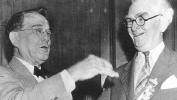 |
In
partnership with U. S. Senator Kenneth McKellar, Crump continued his
domination of Tennessee politics in 1932. He was then a member
of Congress but essentially had no power in Washington, so he
picked his successor for Congress (Walter Chandler) and went back to
Memphis where his authority was relatively unchallenged.
He assembled a coalition of old-time Democrats, local civic and
social groups, and groups of African Americans to vote his way.
He arranged to pave streets in the black parts of town and to
develop a new park for African Americans in order to get their
support.
|
|
Senator McKellar - Crump
|
|
|
|
|
|
Crump backed a
city commission in Memphis to help fund temporary
employment for out of work people and to give food and clothing to
needy people. After the 1937 flood of the Mississippi, Crump
pushed for a flood control project for the county. He and
other Tennessee lawmakers were influential in persuading the federal
government to invest $9 million in the project.
For twenty
years, Crump had kept a card index of every white voter. He
knew how everyone voted and because he controlled every public job,
he could pressure city workers and their families to vote for
whomever he chose.
|
 |
| |
Crump |
|
|
|
|
|
|
In 1939 Crump was elected a
final time as mayor, although that term was actually served by
Walter Chandler. At the time Chandler was U.S. Representative and
Crump thought that Chandler's time was better spent with
congressional matters in Washington than in local campaigning for
mayor. So, without a platform, without a speech, and
without opposition, Crump ran and was elected mayor of Memphis. He
resigned immediately and the next day, the City Commission met
and unanimously elected Chandler as Mayor.
|
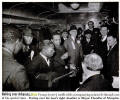 |
| |
Crump - Chandler |
|
|
|
|
|
|
<> <> <> |
|
|
|
|
 |
By
now, Crump had accomplished all his goals for Memphis, which were
established when he first ran fro office. He had gotten flood
control, pushed private utility companies into public ones, and
gotten the state legislature to allow counties to decide whether or
not they wanted liquor sold there. Crump
usually preferred to work behind the scenes. After his two
terms as mayor at the beginning of his career, he essentially named
the next several Mayors of Memphis. And after years of working
behind the scenes, he decided to run for U.S. Representative in
1930. Crump was easily elected and served two terms. In
1936 he was named to the Democratic National Committee, serving on
that body until 1945.
|
| Formal
Photo |
|
|
|
|
|
|
|
|
|
|
|
|
|
|
|
|
|
|
|
<> <> <> |
|
|
|
|
|
The
Crump organization used charity events and rewards, such as "Crump
Charity Day at the Fairgrounds", to keep voters happy. If a business were
critical of Crump, they might find themselves being trailed by police
officers and given tickets for the slightest infraction. By
controlling the vote-counting process in Shelby County, Crump could
affect state elections. Election returns from Shelby County
were never turned in until all the rest of the state's voting had
been recorded. This gave the impression (probably correctly)
that Shelby County officials were just waiting to see how many votes
to assign to their favored candidate. Voters who didn't show
up to vote at the polls would have been surprised that they actually
did vote. |
|
|
|
|
|
|
|
Whenever the Cincinnati excursion vessel,
“Island Queen” arrived in Memphis, Mr. Crump saw to it that she was
not charged a fee for docking. In return orphans, shut-ins,
disabled, military personnel, etc. were taken on a day excursion,
called "Crump's Boat Rides",
including all the refreshments, free of charge. Of course all of the
food and drinks were furnished by many Memphis businesses. No one
refused a request from Boss Crump.
No One!
|
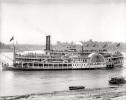 |
| |
Island
Queen |
|
|
|
|
|
|
|
|
<> <> <> |
|
|
|
|
 |
Crump made the cover of Time Magazine in 1946 and was
described as "...the most absolute political Boss in the
United States..."
Although he was still influential in Memphis politics until
his death in 1954, Crump lost a lot of his power in 1948 when
he opposed the election of Harry Truman as president. He
had supported the States' Rights Party who were opposed to
Truman's Civil Rights laws which would have abolished the poll
tax and increased penalties against lynching. Crump's
coalition fell apart as African Americans voted for Truman
instead of with Crump. He was not able to put the
coalition back together. |
| Time 1946 |
|
|
| |
|
|
|
In 1947 "Boss" Crump wouldn't allow the "Freedom Train" to stop
in Memphis because he didn't want integrated crowds to view its
precious original copies of the Declaration of Independence and
the Constitution. The joke was no longer funny. The racism
of this decision was likened to the policies of Hitler by some
black preachers, and progressive Memphians were finally ready
for a change. |
 |
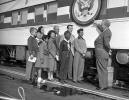 |
| |
Freedom
Train |
Freedom
Train |
|
|
|
|
|
|
|
|
|
|
<> <> <> |
|
|
|
|
|
|
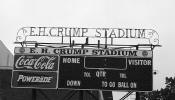 |
Crump's marks on Memphis can be still be seen today. He was a
strong supporter of fire service and for many years the Memphis Fire
Department was considered one of the best in the country and is
still quite well regarded. He felt separate operations for
each municipal utility were inefficient and today, the Memphis
Light, Gas, and Water is one of the largest combined municipal
utilities in the United States. He believed that cities
shouldn't be too noisy. Memphis has strong noise ordinances
that are more aggressively enforced than those of other cities.
He was an early supporter of automobile safety inspections.
All of Memphis-registered vehicles are inspected annually.
|
|
|
|
|
And Crump believed that cities should be clean.
Memphis developed the Clean Up-Paint Up-Fix Up campaign and was
named Tennessee's cleanest city from 1940 through 1946 and the
Nation's Cleanest city for 1948, 49, 50, and 51. Very
interesting, considering that during its early years Memphis was
considered the dirtiest and most foul-smelling place on earth.
While all of these projects and innovations certainly benefited Crump
personally, they also certainly benefited the city of Memphis as
well. Memphis has shown its gratitude in multiple ways... |
|
|
|
|
|
Crump Stadium
Crump Stadium was the Memphis Sports Stadium built in 1934
with a capacity of 7,500. This WPA project was named for
political boss E. H. Crump. In 1939 the stadium was
enlarged to hold 25,000. All high school football games were
played here as well as intercollegiate football games.
E. H. Crump was a frequent visitor for most games
. |
 |
| |
|
|
In 1960
plans were to enlarge the stadium to 45,000 but halted when a new
stadium was built at the Fairgrounds. Crump Stadium was turned
over to the Memphis City Schools. In 2006 the school district
demolished the decaying stadium and replaced it with a stadium "more
appropriate for high school football". |
|
|
 |
 |
 |
 |
 |
|
Crump in stands |
The original gate |
The original Gate-Stands |
The original scoreboard... |
The new Crump Stadium |
|
|
|
|
|
| Crump Memorial
Memorial to Edward Hull Crump located near the Brooks Museum in
Overton Park. "Erected by the people of the city of
Memphis in memory of Edward Hull Crump (1874-1954). His was a
life of dedicated public service, wise counsel, human
understanding, designed to make Memphis the city of good abode.
This memorial sponsored by The Friends of Edward Hull Crump." |
 |
| |
Crump
Memorial |
|
|
|
|
|
|
|
| Crump Steamer
Named after Mayor E .H. Crump. this was the Memphis Fire
Department’s first horse-driven steam fire engine. In the
40s and 50s it was on display in a glass enclosed pavilion in
Overton park. It is now on display in the Memphis Fire
Museum. |
 |
 |
| |
Overton Park Pavilion |
Memphis
Fire Museum |
|
|
|
|
|
|
Crump Building
Built
in 1901, this was the North Memphis Savings Bank. But in 1920 it
became the home of the E. H. Crump Insurance Company and it was
here that "Boss" Crump controlled the city and state through his
political machine. The building is now home to the Chamber of
Commerce and the Center City Commission. |
 |
 |
|
|
The Crump
Building |
|
|
|
|
|
|
Crump Boulevard
Major
Memphis highway named after E. H. Crump. |
 |
 |
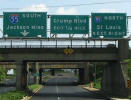 |
|
|
|
|
|
|
|
|
|
|
|
Crump Station
A new police station on Crump Boulevard
which provides services to the most densely populated areas of
Memphis. This is the area to many of Memphis' oldest
neighborhoods. |
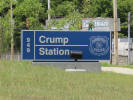 |
| |
Crump
Station |
|
|
|
|
|
|
|
|
|
|
|
|
|
|
<> <> <> |
|
|
|
The Georgia Tann association...
Crump's association with Georgia Tann is a less flattering view of
his legacy. Georgia Tann enjoyed his powerful protection in Memphis
as she illegally placed babies in adoptive homes. Often these
babies were stolen. Ironically, Crump's association with
Georgia Tann lives on:
32 states still have sealed birth certificates for adoptees. |
 |
 |
| |
Georgia
Tann |
Judge C.
Kelly |
|
|
|
 |
By 1924 Georgia Tann was
working for the Tennessee Children's Home Society Orphanage, and
specialized in adoptions. Judge Camille Kelly has spent
two years in medical school before marrying a prominent
attorney. She became the first female Juvenile Court judge
in the south. At some point Judge Kelly and Georgia Tann
apparently reached a business agreement. As a child
custody case was brought before the court, the judge would award
guardianship to the orphanage. From that point, the child
could, and would be adopted - all quite legal.
The orphanage received $7 for each child adopted
|
|
|
|
|
within the State of Tennessee.
But out-of-state adoptions cost as much as $5,000. The money
was split between the judge and Georgia. Some of the people
who adopted were quite famous, such as actress Joan Crawford, actor
Dick Powell and his wife June Allyson, writer Pearl S. Buck, actress
Lana Turner, and western actor Smiley Burnette. It was very profitable to market to out-of-state
wealthy people. |
|
|
|
Tann didn't work alone; she bribed and paid off law enforcement,
media, attorneys, and medical personnel. Memphis Mayor Crump
knew about these activities. Tann employed “spotters” to scout for
children to steal and parents to scam.
From the 1920’s into the 1950’s it's impossible to know how many
children went through her Children’s Home. Many children
died as a result of neglect and abuse. Others were starved, beaten, molested,
Only when dedicated social worker Anne Beals began chipping away at
Tann's respectable veneer did the terrible truth come to light.
But Georgia Tann was never punished for her deeds. She died of
cancer before the investigation was complete. |
|
|
|
|
|
<> <> <> |
|
|
Burial in historic
Elmwood Cemetery
E. H. Crump died on October 16, 1954 and is buried in Memphis
Elmwood Cemetery.
He had his headstone installed before his death
and the legend is he would bring a picnic blanket and eat lunch
admiring it. |
 |
|
|
|
|
|
|
|
|
Crump had
been able to discard some of the more objectionable of his machine's
practices because he knew that clever politicians will ultimately
give the people the government that they want. What
Crump wanted was power - not money. With power, there was no
need for anyone to steal one single cent. And he did have a
sincere love for Memphis and Memphians - as long as they agreed with
him. With Crump, Memphians had gotten efficient government
services, law and order, lower taxes, and a clean, quiet, beautiful
city.
Was the
trade-off worth it? |
|
|
|
|
|
|
|
|
|
|
|
|
|
|
|
|
|
|
|
|
|
Credits |
|
|
|
The
Historic-Memphis website does not intentionally post copyrighted
photos and material without permission or credit.
On
occasion a "non-credited" photo might possibly be posted because we
were unable to find a name to give credit. Because of the nature of
our non-commercial, non-profit, educational website, we strongly
believe that these photos would be considered "Fair Use. We have
certainly made no monetary gain, although those using this website
for historic or Genealogy research have certainly profited. If by
chance,
we have posted your copyrighted photo, please contact us, and we'll
remove it immediately, or we'll add your credit if that's your
choice. In the past, we have found that many photographers
volunteer to have their works included on these pages and we'll
also do that if you contact us with a photo that fits a particular
page. |
|
|
|
The "Historic-Memphis" website would like to acknowledge and thank the
following for their contributions which helped make this website
possible:
Memphis
Public Library, Memphis University Library, Memphis Law Library,
Memphis Commercial Appeal, Memphis Press Scimitar, Shelby County
Register of Deeds, Memphis City Schools, Memphis Business Men's
Club, Memphis Chamber of Commerce, Memphis City Park Commission,
Memphis Film Commission, Carnival Memphis, Memphis Historical
Railroad Page, Memphis Heritage Inc, Beale Street Historic District,
Cobblestone Historic District, Memphis Historic Districts, Vance
Lauderdale Family Archives, Tennessee State Archives, Library of
Congress, Kemmons Wilson Family, Richard S. Brashier, Lee Askew,
George Whitworth, Woody Savage and many individuals whose assistance is
acknowledged on the pages of their contributions. Special
thanks to Memphis Realtor, Joe Spake, for giving us carte blanche
access to his outstanding collection of contemporary Memphis photos.
We do not have high definition copies of the photos on these
pages. If anyone wishes to secure high definition photos,
you'll have to contact the photographer or the collector.
(To avoid any possibility of contributing to SPAM, we do not
maintain a file of email addresses for anyone who contacts us). |
|
|
|
|
|
|
|
|
|
|
|
|
|
|
|
|
|
|
|
|
| |
|
|